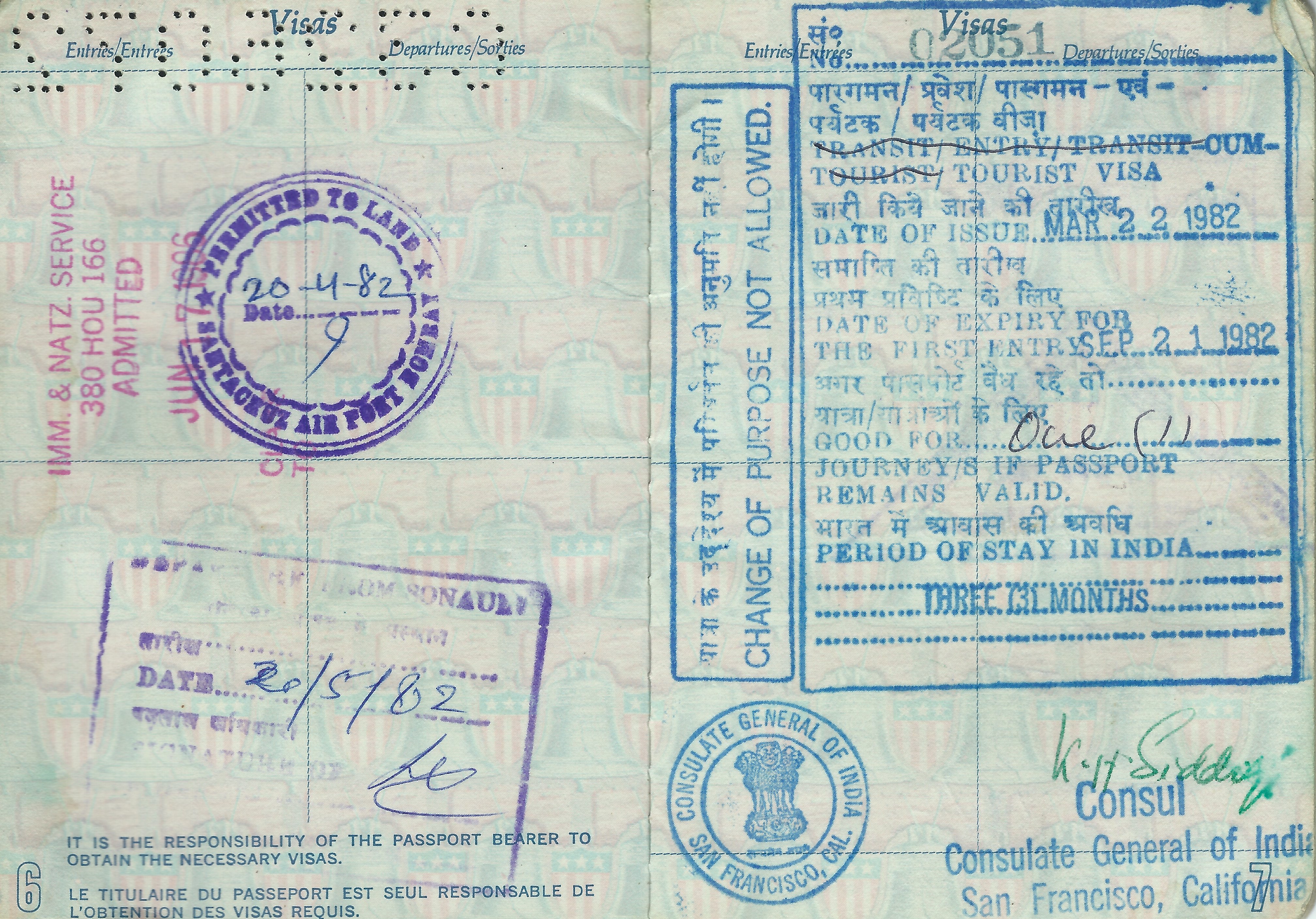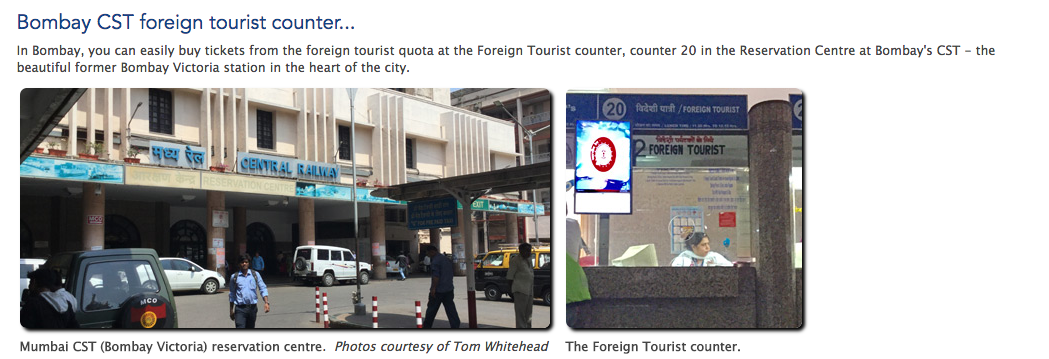While I was learning to play the Third World traveller game in Bangkok, Thailand, back in the spring of 1982, I started talking to my Youth Hostel cohort about going to India where I was planning to stay 2-3 months. Several people, who were seasoned world travelers and had been to India, raised their eyebrows and started telling me about something called “culture shock.” They said I will get culture shock in India.
I really had no idea what they were talking about. They said it was hard to explain but that India will challenge me in ways I have never been challenged. It will take my world and turn it upside down. They suggested there was nothing I could do about it except to leave India when it hit me. They didn’t say, “Don’t go to India.” They simply said, “Just be aware of it.”
After all the crazy stuff I got involved with in Thailand, it was hard to imagine what might cause me to get culture shocked in India. But this ominous warning was in my mind as the Aeroflot (the national airline of the Soviet Union) jet I was flying on landed in Bombay (today called Mumbai) on 20 April 1982. When was this culture shock going to happen? When was it going to happen? Right away? After a few weeks? What was going to trigger it?

I must admit that my first 24 hours in India did lead me to continually wonder whether I was being culture shocked. The plane landed close to midnight so it was pretty late to be heading into a large city like Bombay with no sense of where I was going. All I knew was I wanted to head in the direction of the fancy Taj Mahal Hotel because I had been told there were a lot of cheap dives nearby and the easiest way to get to them was to take the bus going to the Taj Mahal Hotel. It was easy enough to find the right shuttle bus, even at that hour of the night, so the first hurdle was easily cleared. Having to shoo away the young boy who was trying to take my backpack and put it on the bus in hopes for baksheesh was kid’s play.
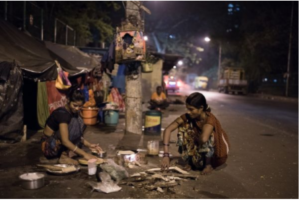
On the hour-long bus ride from the airport into the city, I saw a lot of things that I wondered whether they might cause someone culture shock. The streets were abuzz with people, even little kids, even in the wee hours of the night. The sidewalks were lined with little shacks that people had seemingly just thrown up because there was no other place to live. Hmm, I said. I wonder how these people live? But I told myself that doesn’t really shock me. I’ve seen homeless people before, even in the United States. It’s just a matter of degree.

When the bus got to the Taj Mahal Hotel, touts immediately came up to ask if I wanted a cheap room. I said yes. On the same bus was this Canadian girl who was traveling by herself. She asked if I wanted to share a room?
Hmm. I hadn’t done that before. Accept an offer to room with a complete stranger, let alone a young woman. I guess that was the way to travel even more cheaply than I had been. I could tell she was much more experienced at this traveling thing than I was. The idea of a woman asking a complete stranger to share a room took me aback but I said “Sure.”
We walked off down the street with a tout as he went and knocked on a door. Someone opened the door and the two of us went in and were shown what was essentially a cubicle with a queen-sized bed and a door. The paper-thin walls only went up like ten-foot high. There was no ceiling. Wow, this was definitely a dive. But I was splitting like 50 cents to stay here. And they let us in in the middle of the night. So good enough!
Just as I got my mind wrapped about that, the Canadian girl ratcheted things up a notch by taking off her top exposing what I recognized as very large breasts. She also had an incredible amount of ugly acne all over her back! Eeeek! She stripped down to her panties and got into bed. OK, somehow I wasn’t quite expecting that!
What was I supposed to do? Should I strip down to my underwear? Should I just get into bed and go to sleep? Did she want me to touch her? Did she want to make love? Or was this strictly a financial arrangement, to save 25 cents on a dive? What were the rules to this part of the game?
Needless to say I didn’t get much sleep that night trying to figure this one out. And I was too chicken butt to even try something. As far as I know she slept like a baby. She had obviously done this before and, I guess, had never had any problems because she was doing it again. Maybe it was a game to her. Or maybe she sized me up as a chicken butt!
In the morning she was taking the train to somewhere else. I asked if she wanted to go have breakfast and she said “Sure.” We went to a little restaurant, had breakfast, and then she caught a taxi to somewhere. We said goodbye. We never touched and I never saw her again.
OK, definitely weird. But this episode with the Canadian girl really had nothing to do with India and I can’t say it was “culture shock.” It was just weird.
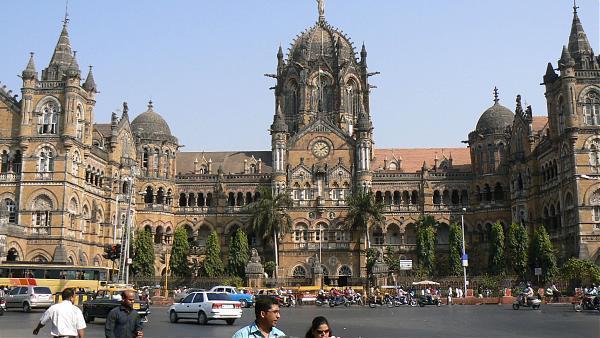
Later that morning I walked to the Victoria Terminus railway station so I could get a ticket to go to Madras (today called Chennai) for the following day. I had taken an overnight train from Chiang Mai to Bangkok while I was in Thailand so I knew a bit about catching trains. But my Thai experience did not prepare me at all for Bombay.
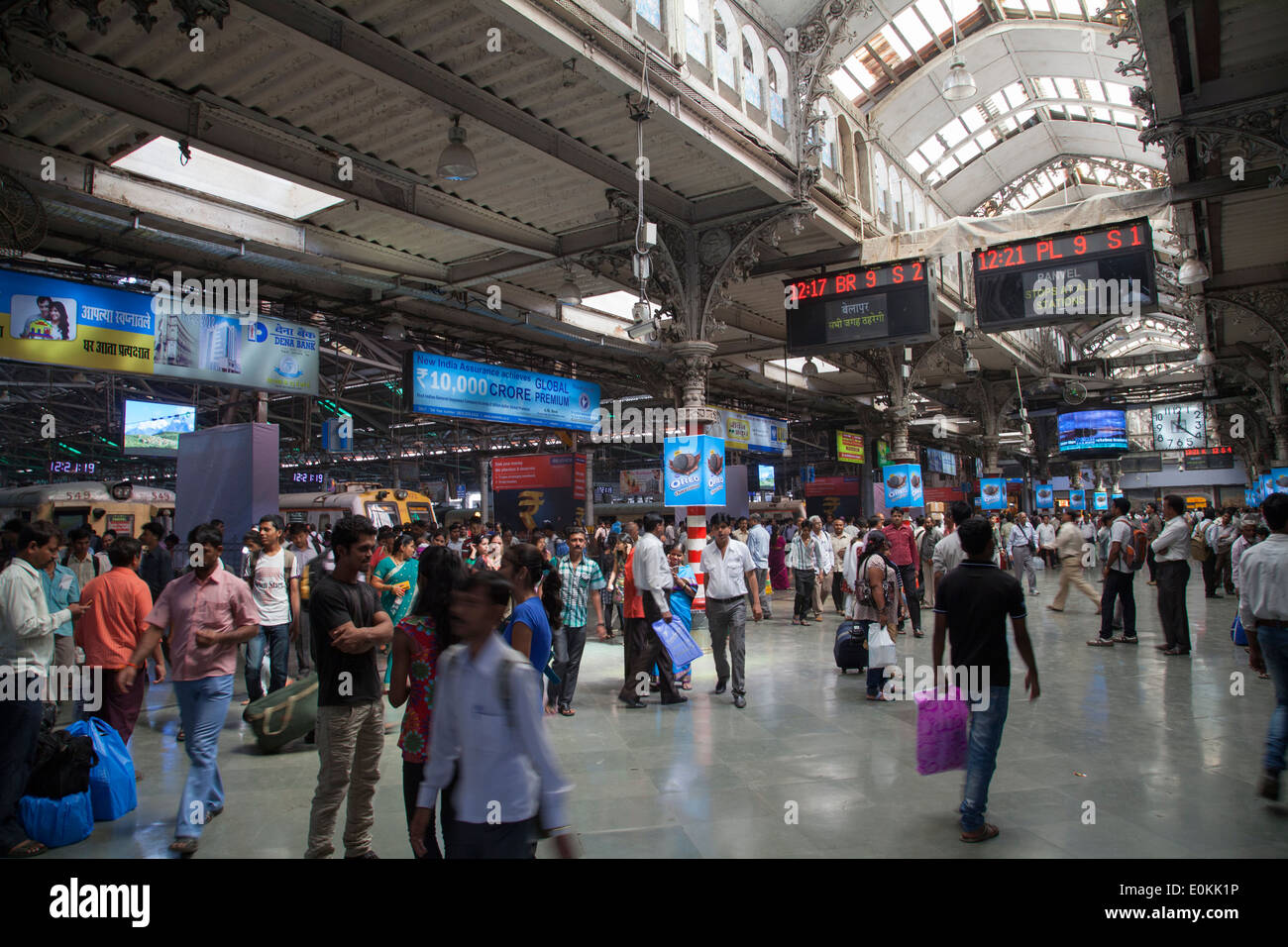
Entering the main entry area of the main train station in Bombay, I saw only one very long line going up to the ticket windows. Hmmm. All these people trying to get a ticket and only one window open. That sucks.

I dutifully got in line and waited. And waited. And waited. The line was inching forward, very, very, very slowly. After an hour, I had hardly moved up at all. I started having doubts whether I was going to even get a ticket that day.

I decided to put on “my American hat” (i.e., act like an obnoxious American tourist) and go right up to the window and ask the ticket agent whether I was even in the right line. It wasn’t like I was trying to cut (although I was). I just wanted information.
Fortunately for me the ticket agent – who I could see was working with big handwritten ledger books rather than computers like we had in the United States – told me I was, in fact, in the wrong line. I was frustrated that the hour I spent waiting in line was for naught, but I was ecstatic to hear that foreigners did not have to wait in this long line. There was a special tourist office in the station that would help me. Ka-ching!
Unfortunately when I went to the tourist office, no one was there. The office was open but no one was in there. I sat down and waited. And waited. And waited. I went back to the ticket agent to make sure it was the right office and he reassured me it was. He suggested maybe they were at lunch. So I went back and waited. Eventually after about an hour, a person came into the tourist office and informed me that while they couldn’t sell me a ticket, they could give me a voucher to get a ticket. But I had to have the voucher signed by the stationmaster.

OK, so off I went with voucher in hand to find the stationmaster. When I entered the stationmaster’s office, I was surprised to see the reception area jammed pack with locals. And I don’t mean sitting in chairs. The room was literally wall-to-wall packed with people standing, all waiting to go through a door on the opposite wall which was obviously the station master’s actual office. And none of them looked like tourists.
I had no idea how this system worked. From what I could tell there was no queue. It was just a mob. So again I put on “my American hat” and started pushing through the mob and went through the door only to find another room jam packed with locals all trying to get the attention of the beleaguered station master who was standing behind his desk while people kept thrusting papers at him. The din was deafening. Oh my God! This is insane.
I realized my only chance was once again to plow through this mob right to the stationmaster. Fortunately when I got to him, he immediately took notice of me – undoubtedly because I was a foreigner – and took my voucher and signed it. I then proceeded to push my way back out of the office and reception area until I was out in the main train station again. I felt like a man freed from the notorious Black Hole of Calcutta! I can breath again!
With signed voucher in hand, I went back to the Tourist Office to see what I was supposed to do next. Unfortunately, once again no one was in the office. Were they at lunch again? Again I sat down to wait. About 30 minutes later the same guy showed up and said now I have to take the voucher to the ticket window.
My mouth dropped open. You mean the same window with a line that I waited in for like an hour this morning, only to be informed after I put my American hat on that I was in the wrong line?
Yes, indeed, that same line! Oh, but because I was a tourist, I did not have to wait in line. I could go right up to the front, just like an American! And I did just that and bought my ticket. The whole ordeal only took me about three hours but I was pretty sure that some of the people I was in line with in the morning were still there!
If you think that was enough of an ordeal for one day, you are sadly mistaken. My first 24 hours in India was not even half over!
As I was leaving the train station with my ticket, a man came up and asked me whether I would like to see something “interesting”. I took him at first for a tout but he was very well dressed, spoke English very well, and seemed highly educated, unlike all the touts I had met in Thailand or Malaysia, so I was curious. I happened to meet a few of these English-speaking gentlemen in India, a very different experience from Thailand where even educated people spoke little to no English back in 1982.
I asked the Indian gentleman what exactly he wanted to show and how far away it was. But he was very mysterious, saying “Be patient. I assure you it will be worth it.” So we started walking and he kept up a constant monologue about Bombay and India. Fascinating stuff. And I kept asking where we were going and he would reply “Be patient.” After about a mile of walking the city streets, we finally arrived at the place. It was behind a concrete wall so you couldn’t see in from the street. But when a gate was opened I didn’t know what to make of it.

The Indian gentleman showed me to a pile of wood and something that looked like an Egyptian mummy all wrapped up in white cloth lying on top of it. He told me this was a corpse and they were getting ready to cremate it by lighting the wood of fire. He told me Hindus had to cremate their dead and because of the scarcity of wood in India (undoubtedly all used up because of all the cremations) it was very expensive. He said it cost about $20 to cremate a body. And that’s when this other guy came up to us and asked me if I would like to make a donation to help offset the cost.
OK, here it was. This was the set-up. The guy was a highly sophisticated tout. He did take me to something that was fascinating, something that I would always remember and that I would never have even thought of, let alone find on my own. But now I was expected to give some money for this experience. I immediately felt like I wanted to give something, but how much would be enough? $20, the cost of one of these cremations? After a few moments thought, I decided to give the guy $20.
OK, I was alright with that. But then another guy came up to me and said other groups besides Hindus cremate bodies. He represented some other group, I can’t remember which group. I don’t think it mattered. I gave him $20 as well and then turned around and marched through the fence gate and out of the yard. I was furious. I had only given them $40 yet I felt like I had been suckered. $40 was nothing. It was the sense that I had been suckered and it had all happened so fast. I didn’t have to give them anything and yet I would have felt bad if I hadn’t. What had been a positive experience had suddenly become a negative experience.
The Egyptian gentleman that had brought me to the crematorium caught up with me as I was marching down the street in and tried to talk me into going to some other “interesting” place. I had no idea where I was going but I empathically told him “I was not interested.” He kept pestering me and I kept saying “No! No!”
Finally he got the point that I was not interested in going anywhere else with him and then he started suggesting that he deserved some kind of tip for having taken me to the crematoria. I was pretty certain that he must be receiving some finder’s fee for bringing me to the crematorium in the first place so I felt no guilt whatsoever about not giving him anything. I was furious with him for having suckered me. Maybe he didn’t know I felt suckered and thought I just didn’t know that you are supposed to tip people who come up to you and offer to take you on an adventure if the adventure proves to be truly adventurous. But he should have realized I was furious and was just trying to guilt or annoy me into giving him probably the same kind of money I have given the two guys back at the crematorium. Eventually he gave up and went away cursing me for wasting his time. Chalk up another Third World lesson learned. If you go on an adventure with a stranger, realize you may have to pay for it in one way or another or else things may get nasty.

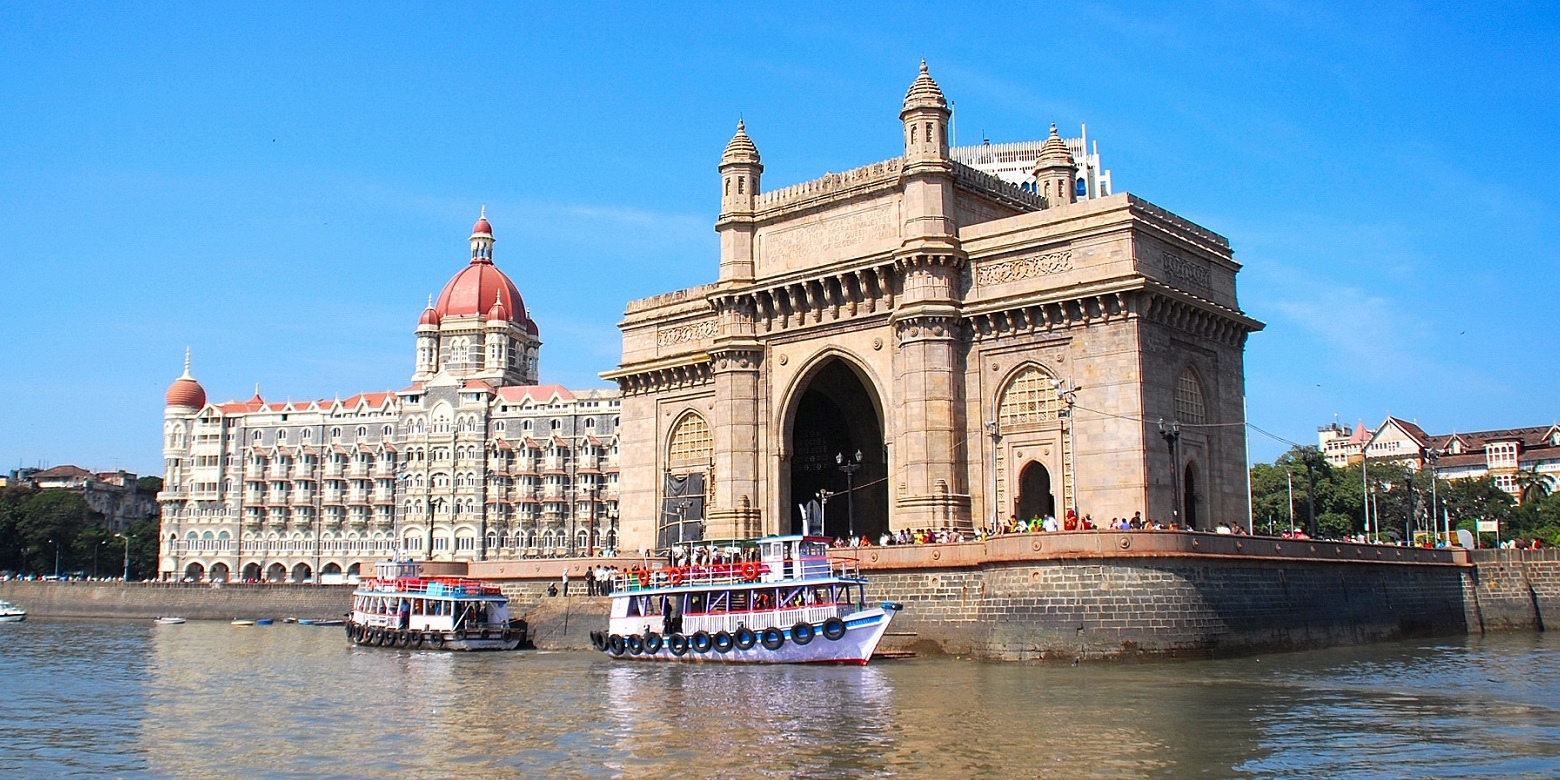
But the day was not over yet. Somehow or another I made my way back to cheap dive I was staying in. (I had decided to spend a night in the same place even though my Canadian roommate had split.)
I remember walking around the Gateway of India, one of the tourist attractions of Bombay. (You can see it in the foreground with the Taj Mahal Hotel in the background.) Because it was such a tourist area there were dozens of touts hawking their wares. They were quite brazen, offering to sell (or buy) anything from watches (always Rolex) to drugs.

I had some time to kill so I decided to take a boat launch (like the ones you see above in front of the Gateway of India) out to Elephanta Island. I knew nothing Elephanta Island but I liked the idea of a boat ride and it was something tourists did in Bombay so I thought I take a look.
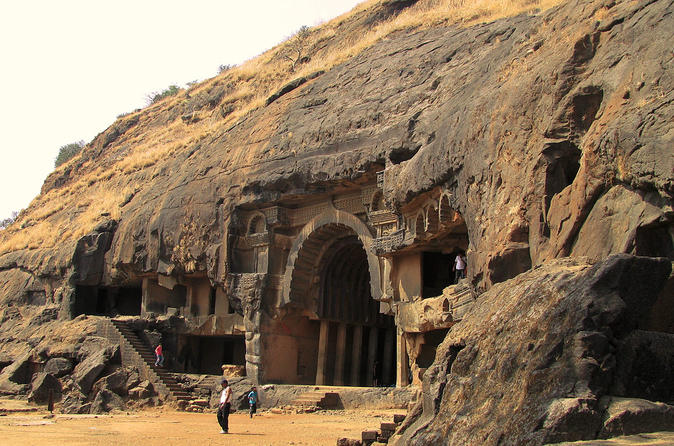

Although there was a lot to explore on Elephanta Island, I don’t think I stayed there over an hour. I remember distinctly a lot of three-headed statues like the one above on the right but I found it all a little too overwhelming. Maybe when I learned something about Hinduism it would make more sense.

After returning from Elephanta Island, I hit on the idea of capping off the day by taking a taxi to the highest point in Bombay where I could hopefully get a good view of the city and Back Bay. So I caught a taxi and asked the driver where should I go. He suggested the place to go was Malabar Hill on the other side of Back Bay from the Gateway of India.
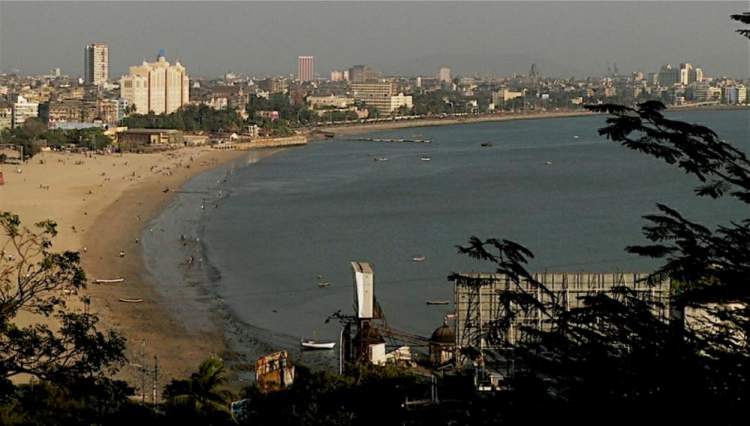
The taxi driver sure knew his stuff because he took to a gem of a park called the Hanging Garden perched atop Malabar Hill with a gorgeous view of the Arabian Sea.
The park itself was this little oasis above the hustle and bustle of Bombay. There were quite a few people, but not too many, just walking along the pathways in the park.
As I was enjoying myself, just wandering along the paths, a gentleman came up to me and started walking next to me trying to engage me in conversation. Uh oh, here we go again!
Gent: How do you like the park?
Me: I love it. So peaceful.
Gent: Do you know what you are walking on?
That sounded like a weird question to me.
Me: I don’t know. Dirt? Grass?
Gent: No. I was walking on the water reservoir for Bombay. Underneath the dirt and grass was all the drinking water for the entire city of Bombay. Back in the 1800s the reservoir had been open to the sky. But in the late 1800s the city planners decided to build a cover over the reservoir and plant a garden on top of the cover? Do you know why they did that?
Me: I have no idea.
Gent: Well, you see up there [pointing to the woods to the north] the Parsis have what they call Towers of Silence. The Parsis are Zoroastrians who fled Persia over a thousand years ago to escape the conquering Arabs. In India they are called Parsis because they were from Persia. And they moved here and built these Towers of Silence. Do you know why they built these Towers of Silence?
Me: I have no idea.
I craned my neck to make out what the gentleman was pointing at. I had the impression that I should have seen something but I saw nothing but woods.
Gent: They place their dead in these buildings. They believe both earth and fire are too sacred to either bury or cremate the corrupt flesh of the corpse. Instead they place their dead in these Towers of Silence. The Towers are open to the sky which allows vultures to fly in and devour the corpses, the only proper way to dispose of corpses.
Me: What? That’s crazy! You’ve got to be kidding me!
The idea shocked me. I always thought of vultures as incredibly ugly birds and the idea of them feeding on dead humans was quite gross.
Gent: It is the truth. Now getting back to the question of why they covered the city’s reservoir and built the Hanging Garden on top of it, it seems back in the late 1800s there were reports that the vultures were dropping bit of putrefying flesh in the reservoir as the flew from the Towers of Silence back to their nests, contaminating the water.
Me: Gross!
Gent: But look. We got a beautiful garden out of it!
I thanked the gentleman for his story which has stuck with me to this day. Unlike the gentleman I met earlier in the day, this gentleman wanted nothing from me except to share with me something of his city. And I thanked him very much and bade him farewell. It was time to get back to shabby dive before it got too dark.
As crazy and frustrating as had been my first 24 hours in India, I had to say I did not get culture shock. I was ready to see the rest of India and see what else it had to challenge me in a way that I had never been challenged.
Sometime around midnight my craziest twenty-four hours came to an end but I was sound asleep by then.
2017 Update
It has been 35 years since my craziest twenty-four hours and I wondered about some of things I remember so vividly from that experience.
As for booking train tickets in Mumbai, there is apparently now a Foreign Tourist counter rather than a Foreign Tourist office. Yippeee!
I checked on the cost of cremating corpses. The average cost of cremation by open wood fire in India is currently between 2,000 and 3,000 rupees ($30-50 US). 1
Hindus overwhelmingly continue to support tradition open air cremation over more efficient crematoria and “electric cremation” using hydroelectric power despite the 50 to 60 million trees that have to be burned each year causing terrible deforestation and environmental pollution.
Rumani Saikia Phukan explains the traditional belief in open cremation thusly:
All Hindus believe that the soul of a dead person must be completely detached from the body and the material world, so that it can be reincarnated again. For this, an open cremation is needed so that the soul can be easily released as soon as the body is burned atop a massive pile of wood. Draped in a white cloth, when the body is burned on the pyre of wood, prayers are chanted. The soul gets engulfed in the flames and releases from the body. This traditional belief and ritual has been followed since time immemorial by the Hindus and traditional Hindu funeral pyre is the most auspicious method, considered by the Hindus for the dead person’s soul to rest in peace. 2
Looking at aerial/satellite images of Malabar Hill and photographs of Bombay from the early 1980s, it is clear that I would not have been able to see the Towers of Silence from the Hanging Garden.
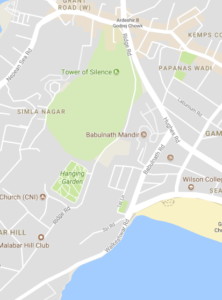
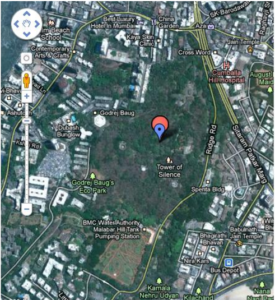
The maps above show the Hanging Garden due south of large green area in which there are actually a grand total of seven Towers of Silence although most of those seven have long been inactive. 3
In this aerial photograph, you can see the Hanging Garden in the background and at least two of the Towers of Silence quite clearly.

Here is a photograph taken sometime in the late 1970s to early 1980s that shows one of the larger Towers of Silence.

In both photographs, it is clear that the top of even the largest Towers of Silence lies below the tree line and thus one could not see them from down at the level of the Hanging Garden.
That the Parsis were using the Towers of Silence on Malabar Hill circa 1980 is clearly shown in this quite disturbing aerial photograph.

Khandias delivering a corpse to a dakhma in Mumbai as vultures wait
There is also a short video of “Vultures circling over Mumbai’s Towers of Silence” on YouTube, published on 22 Feb. 2011, although it is not clear when this video was actually shot.
Although there has been some local pressure on the Parsis to cease the use of Towers of Silence for all kinds of reasons accompanying urban sprawl, the greatest threat to the practice has been the almost complete wiping out (99.9%) of the vulture population across the Indian subcontinent. The introduction of the drug Diclofenac for the treatment of inflammation, fever, and pain in cattle was highly poisonous to the vultures who fed on livestock carrion and wasn’t banned by the Indian government until 2006. Efforts like captive vulture breeding programs and “solar concentrators” (using mirrors to speed up decomposition) have yet to prove effective solutions.
Notes:
- https://www.quora.com/How-much-does-cremation-cost-in-India ↩
- Rumani Saikia Phukan, “Electric Cremation vs The Traditional Funeral Pyre,” MapsofIndia.com, 7 Aug. 2017, http://www.mapsofindia.com/my-india/society/electric-cremation-vs-the-traditional-funeral-pyre ↩
- “Defunct Tower of Silence Lives on in the Heart of an Andheri Residential Colony, Times of India, October 28, 2014, http://timesofindia.indiatimes.com/city/mumbai/Defunct-Tower-of-Silence-lives-on-in-the-heart-of-an-Andheri-residential-colony/articleshow/44954598.cms ↩

